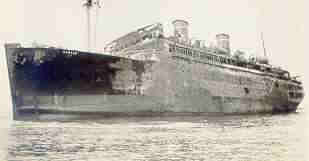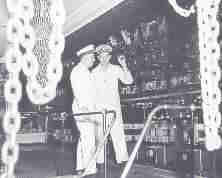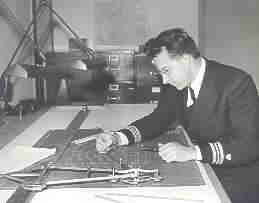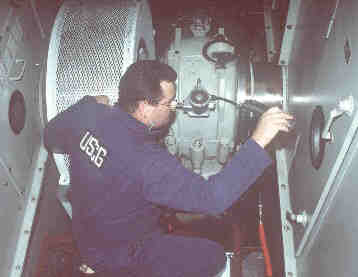
~

The Steamboat Inspection Service


The safety inspection of merchant vessels documented under the flag of the United States has been authorized in varying degrees by Congress and required by law since 1838. The Steamboat Inspection Service was created for the safeguarding of lives and property at sea. In the early days Congress hesitated to pass adequate safety laws because of fear of interfering with the growing steamboat industry which was playing a big part in the country's economic development. However, as the industry grew and the general public became aware of the need for maritime safety laws, Congress began to act to protect the public, beginning with passing a law on July 7, 1838 to "provide better security of the lives of passengers on board of vessels propelled in whole or in part by steam" (5 Stat. L., 304). The law was enforced by the Justice Department. Experience showed the greatest casualties were caused by boiler explosions and by fire aboard ship.
The beginning and development of a federal maritime safety program arose from disasters which caused much death, injury and property loss. The public's growing concern over these maritime accidents prompted congressional action. Maritime safety laws were passed. Captain Edward Tripp introduced steamboating to Baltimore in 1813 with the building of the steamboat Chesapeake. Also, Captain Tripp was the first Baltimore hull inspector and was appointed by a federal district judge to perform the safety inspection on the few vessels in Baltimore. Captain Tripp performed these duties between 1838 and 1852. At that time the law provided a $5.00 fee for each inspection to be paid by the vessel's owner.
Steamboat Act of May 30, 1852
The 1838 law proved inadequate as steamboat disasters increased in volume and severity. The 1847 to 1852 era was marked by an unusual series of disasters primarily caused by boiler explosions, however, many were also caused by fires and collisions. These disasters resulted in the passage of the Steamboat Act of May 30, 1852 (10 Stat. L., 1852) in which enforcement powers were placed under the Department of the Treasury rather than the Department of Justice as with the Act of 1838. Under this law, the organization and form of a federal maritime inspection service began to emerge. Nine supervisory inspectors responsible for a specific geographic region were appointed. There were also provisions for the appointment of local inspectors by a commission consisting of the local District Collector of Customs, the Supervisory Inspector, and the District Judge.
The important features of this law were the requirement for hydrostatic testing of boilers, and the requirement for a boiler steam safety valve. This law further required that both pilots and engineers be licensed by the local inspectors. Even though time and further insight proved the Steamboat Act inadequate, it must be given credit for starting legislation in the right perspective. Probably the most serious shortcoming was the exemption of freightboats, ferries, tugboats and towboats, which continued to operate under the superficial inspection requirements of the law of 1838. Again, disasters and high loss of life prompted congressional action through the passage of of the Act of February 28, 1871.
Act of February 28, 1871 & the Creation of the Steamboat Inspection Service
This act retained the useful function of the prior acts and added new requirements which provided a comprehensive Marine Safety Code, on which our present marine safety code has been built. The organization created by the Act of 1871 became known as the Steamboat Inspection Service. This new law sought to protect the crew as well as the passengers and applied to all steam vessels. Furthermore, it established a Supervisory Inspector General directly responsible to the Secretary of the Treasury, extended licensing requirements to all masters and chief mates, provided for the revocation of licenses, authorized periodic inspection and gave the Board of Supervisory Inspectors the authority to prescribe nautical Rules of the Road. On February 14, 1903, congressional action transferred the Steamboat Inspection Service to the newly created Department of Commerce and Labor. It remained here until its functions were transferred to the Coast Guard during World War II. Prior to that time, it was merged with the Bureau of Navigation, itself created in 1884 to oversee the regulation of merchant seamen, on June 30, 1932 (47 Stat. L., 415). This "new" organization was named the Bureau of Marine Inspection and Navigation and remained within the Department of Commerce.
Act of May 27, 1936 (Public Law 622)
 The Morro Castle
(left) fire off
the coast of New Jersey in 1934, which caused the loss of 124 persons, paved
the way for the Act of May 27, 1936. The law, known as Public Law 622,
reorganized and changed the name of the Bureau of Navigation and Steamboat
Inspection Service to Bureau of Marine Inspection and Navigation (49 Stat.
L., 1380). The Bureau remained under Commerce Department control. Public
Law 622 also required structural fire protection on passenger vessels and
required plans for passenger vessels be approved by the Bureau prior to any
vessel's construction.
The Morro Castle
(left) fire off
the coast of New Jersey in 1934, which caused the loss of 124 persons, paved
the way for the Act of May 27, 1936. The law, known as Public Law 622,
reorganized and changed the name of the Bureau of Navigation and Steamboat
Inspection Service to Bureau of Marine Inspection and Navigation (49 Stat.
L., 1380). The Bureau remained under Commerce Department control. Public
Law 622 also required structural fire protection on passenger vessels and
required plans for passenger vessels be approved by the Bureau prior to any
vessel's construction.
Motorboat Act of 1940
The Motorboat Act of 1940 was enacted to cover safety requirements for every vessel propelled by machinery and not more than 65-feet in length, with the exception of tugboats and towboats of this length propelled by steam, which were covered under other laws. In addition to covering safety equipment, running lights, and reckless or negligent operations, this law gave the Bureau of Marine Inspection and Navigation the authority to examine the operators of these boats and issue licenses provided they carried passengers for hire.
Executive Order 9083

On February 28, 1942, President
Franklin Roosevelt, as a wartime measure, signed Executive Order 9083, which
transferred the Bureau of Marine Inspection and Navigation temporarily to
the control of the U.S. Coast Guard. This transfer was made permanent
by Reorganization Plan Number 3 on July 16, 1946. This marked the first
time in the nation's history that all functions of maritime safety came under
one agency.
Small Passenger Vessel Act of May 10, 1956
 Due
to an increase in small boat accidents, the Small Passenger Vessel Act
of May 10, 1956 was passed into law. The requirements of this act
became effective on June 1, 1958, and provided that all vessels, regardless
of size or propulsion, carrying more than six passengers for hire, be inspected
by a Marine Inspector of the Coast Guard, and meet associated safety
requirements. These requirements not only cover life saving and fire
fighting equipment, but also machinery and electrical installations, hull
strength and stability considerations. This law required that operators
be licensed by the Coast Guard and minimum manning requirements be met.
Additionally, the route or routes on which the vessel may operate and the
maximum number of passengers which may be carried are established by the
Coast Guard.
Due
to an increase in small boat accidents, the Small Passenger Vessel Act
of May 10, 1956 was passed into law. The requirements of this act
became effective on June 1, 1958, and provided that all vessels, regardless
of size or propulsion, carrying more than six passengers for hire, be inspected
by a Marine Inspector of the Coast Guard, and meet associated safety
requirements. These requirements not only cover life saving and fire
fighting equipment, but also machinery and electrical installations, hull
strength and stability considerations. This law required that operators
be licensed by the Coast Guard and minimum manning requirements be met.
Additionally, the route or routes on which the vessel may operate and the
maximum number of passengers which may be carried are established by the
Coast Guard.
 The
Merchant Marine Safety program is still administered by the Coast Guard,
an agency now under the control of the Department of Homeland Security.
In an attempt to promote better service to the maritime industry as well
as the general public, the Marine Inspection and Captain of the Port facilities
were combined. The Merchant Marine Inspectors of the Coast Guard come
from varying backgrounds and careers. Many are graduates of the Coast
Guard Academy while others are graduates of the various state maritime
schools. Many of the officers in this field are prior-enlisted Coast
Guardsmen who have progressed through the enlisted ranks and earned
commissions.
The
Merchant Marine Safety program is still administered by the Coast Guard,
an agency now under the control of the Department of Homeland Security.
In an attempt to promote better service to the maritime industry as well
as the general public, the Marine Inspection and Captain of the Port facilities
were combined. The Merchant Marine Inspectors of the Coast Guard come
from varying backgrounds and careers. Many are graduates of the Coast
Guard Academy while others are graduates of the various state maritime
schools. Many of the officers in this field are prior-enlisted Coast
Guardsmen who have progressed through the enlisted ranks and earned
commissions.

(A version of this article first appeared in the publication Fifth Dimension (Issue 5-D, 1974, pages 6-7). Fifth Dimension was the "unofficial" publication of the Fifth Coast Guard District.
~


1
© 2008 Thru 2010 USCG Lightship Sailors Association International Inc.
Rick Gryder Webmaster
~
~
~